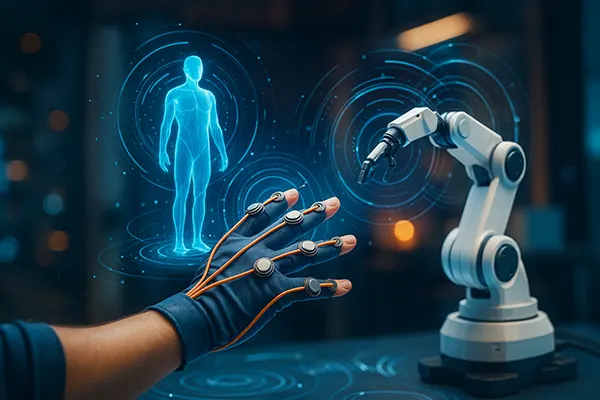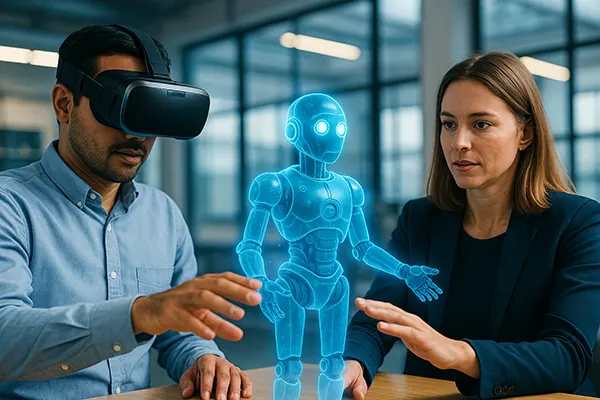Internet of Tactile Level for 6G Industries: Next-Generation Haptic Communication

The transition from 5G to 6G is not just about faster data speeds but about redefining the interaction between humans and machines. One of the most transformative concepts at the core of this evolution is the Internet of Tactile Level — a system designed to transmit not only data and visuals but also touch, motion, and control signals in real time. This article explores how this innovation will reshape multiple industries by enabling next-generation haptic communication.
Foundations of Tactile Internet in 6G
The tactile Internet aims to transmit human touch and movement with ultra-low latency, typically under 1 millisecond. This capability opens new possibilities in sectors such as healthcare, manufacturing, education, and remote robotics. It is a shift from simple data exchange to direct human-machine interaction — a digital sensory extension of our physical bodies.
One of the technical enablers is the integration of ultra-reliable low-latency communication (URLLC) with edge intelligence. These systems allow decentralised processing closer to the user, ensuring near-instantaneous feedback that is critical for tactile feedback accuracy.
6G will also introduce the concept of joint communication and sensing (JCAS), which allows devices not only to communicate but also to perceive their environment using electromagnetic waves. This approach supports real-time detection of pressure, vibration, or movement required for remote control and touch simulation.
Industrial Implications of Tactile Networks
In manufacturing, tactile networks will enable remote control of robots with physical feedback, allowing technicians to “feel” objects through robotic arms from hundreds of kilometres away. This advancement can significantly increase the efficiency and safety of operations in hazardous environments.
In healthcare, surgeons will perform operations remotely with tactile precision, providing the sensation of tissue resistance and texture via surgical robots. This is especially valuable for areas lacking qualified specialists, reducing the necessity for patient travel or evacuation.
Education and training will be transformed through virtual labs where students can feel molecular structures in chemistry or the tension of tendons in medical simulations. This level of immersion improves retention and understanding, bridging the gap between theory and real-world experience.
Core Technologies Enabling Tactile Internet
Realising the Internet of Tactile Level requires a complex integration of technologies. At its base are haptic devices capable of detecting and simulating touch — such as gloves, suits, or exoskeletons — and software systems to interpret those signals.
Artificial intelligence plays a critical role by predicting and correcting latency-related errors. Machine learning models anticipate the user’s movement to compensate for any micro-delay, ensuring the sensation feels immediate and natural.
Network slicing within 6G allows the creation of isolated virtual channels for tactile data, ensuring prioritised delivery. This isolation guarantees that time-critical data streams — such as those used in remote surgery — are not interrupted by lower-priority content like video streaming or file downloads.
Security and Ethical Considerations
With deeper human-machine integration comes increased sensitivity around data privacy and physical autonomy. Transmitting tactile data — essentially physical interaction — requires enhanced encryption, real-time monitoring, and strict access control.
Ethical concerns will arise in sectors such as remote intimacy technologies or behavioural training, where the replication of touch can influence emotions or decisions. Regulation will need to evolve rapidly to address manipulation, consent, and misuse in digital environments.
Another risk involves cyberattacks on haptic channels. An attacker intercepting or manipulating tactile signals in a medical or industrial context could cause severe harm. Therefore, security-by-design is essential from the architecture level of 6G networks.

Use Cases: Future Outlook by 2030 and Beyond
By 2030, many industries will rely on tactile Internet to deliver services previously considered impossible to digitise. Logistics companies may use haptic drones to inspect and repair infrastructure remotely, with field engineers operating from headquarters.
Space agencies will control robotic instruments on distant planets or in orbit, receiving real-time haptic feedback despite the vast distances. In such scenarios, predictive AI models and 6G relays will simulate immediate response even when physical delays exist.
Entertainment and gaming will enter a new era where players physically interact with digital worlds — feeling the impact of an object, the texture of virtual surfaces, or even temperature variations in a story-driven environment. This immersion will redefine user engagement.
Interdisciplinary Collaboration for Development
The development of tactile networks requires collaboration across diverse fields: telecom, neuroscience, mechanical engineering, software design, and ethics. Universities, research institutes, and private companies must synchronise efforts to address technical and social challenges.
Standardisation bodies such as the ITU and IEEE are already forming working groups to define frameworks and compliance requirements for tactile communication. This is vital for global interoperability, safety, and innovation acceleration.
Governments and industry leaders must also ensure accessibility. Tactile technologies should not become luxury tools for a few sectors but be integrated into public services such as disaster response, eldercare, and education for disabled users.
